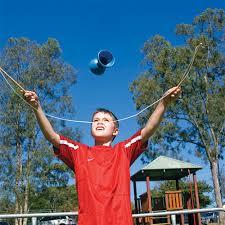Diabolo, often referred to as the “Chinese yo-yo,” is a fascinating juggling prop that has captivated audiences worldwide for centuries. Its rich history, originating in ancient China, has seen it evolve from a simple toy to a sophisticated performance art used in circuses, street performances, and even competitive events. This article explores the history and development of Diabolo, tracing its journey from ancient Chinese roots to its prominent place on the modern stage.
Origins of Diabolo in Ancient China
Diabolo’s history dates back over 2,000 years to ancient China, where it was initially known as “kouen-gen” or “empty bell.” The early Diabolos were made from bamboo and featured a design similar to a spool, with a string passing through its hollow center. The name “kouen-gen” referred to the whistling sound produced when the Diabolo was spun at high speeds. This unique sound, combined with the visual appeal of the spinning toy, made it a popular pastime among the Chinese.
The Diabolo was not only a form of entertainment but also had cultural significance. It was believed that the sound of the spinning Diabolo could ward off evil spirits, making it a common sight during festivals and celebrations. The toy’s simplicity and the skill required to perform tricks with it contributed to its popularity, particularly among children and young adults.
The Spread of Diabolo to the West
The journey of Diabolo from China to the West began in the late 18th and early 19th centuries, during a period of increased trade and cultural exchange between Europe and Asia. Western traders and explorers who visited China were intrigued by the Diabolo and brought it back to their home countries. In Europe, the toy was quickly embraced by both children and adults, who were fascinated by its potential for performing tricks and stunts.
In the early 19th century, the Diabolo became a popular fad in Europe, particularly in France and England. European manufacturers began producing their versions of the Diabolo, often made from materials such as wood and metal, and sometimes featuring elaborate designs. The Western Diabolo was typically larger and heavier than its Chinese counterpart, which allowed for different types of tricks and performances.
Evolution of Diabolo Techniques and Performances
As Diabolo gained popularity in the West, so did the development of new techniques and styles of play. Juggling enthusiasts and performers began experimenting with different ways to manipulate the Diabolo, creating an array of tricks that showcased their dexterity and creativity. The invention of new tricks led to the formalization of Diabolo as a skill-based activity, with competitions and exhibitions becoming increasingly common.
By the late 19th and early 20th centuries, Diabolo had become a staple of European circuses and vaudeville shows. Performers incorporated the Diabolo into their acts, often combining it with other juggling props to create visually stunning performances. The Diabolo’s versatility allowed for a wide range of tricks, from basic tosses and catches to complex maneuvers involving multiple Diabolos or interactions with other objects.
The Modern Diabolo: Materials and Design Innovations
The 20th century saw significant advancements in the design and materials used in Diabolo, contributing to its continued popularity and the development of more sophisticated tricks. Early 20th-century Diabolos were still primarily made from wood and metal, but the advent of new materials such as rubber and plastic allowed for greater durability and flexibility.
Modern Diabolos are typically made from high-quality plastics or composite materials, which provide a balance of weight and durability. The use of rubberized edges and ball bearings has further enhanced the performance of Diabolos, allowing them to spin faster and longer, making more complex tricks possible. Additionally, the design of the Diabolo has become more standardized, with most modern Diabolos featuring a symmetric, hourglass shape that is well-suited for a variety of tricks.
Diabolo in Contemporary Culture and Competitions
In recent decades, Diabolo has experienced a resurgence in popularity, driven by its inclusion in juggling festivals, street performances, and even professional competitions. The rise of the internet and social media has also played a crucial role in the spread of Diabolo culture, with performers sharing their tricks and routines with a global audience.
Today, Diabolo is recognized as both a form of entertainment and a competitive sport. Diabolo competitions are held worldwide, with participants showcasing their skills in various categories, including freestyle, speed, and multiple Diabolo routines. These competitions have contributed to the ongoing evolution of Diabolo techniques, as jugglers push the boundaries of what is possible with this versatile prop.
Diabolo has also found its way into mainstream entertainment, with performers incorporating it into live shows, television programs, and even films. Its visual appeal and the skill required to perform tricks have made Diabolo a favorite among audiences of all ages. In some cases, Diabolo has been used as a tool for education, helping to develop hand-eye coordination, concentration, and creativity in both children and adults.
The Future of Diabolo
As Diabolo continues to evolve, its future looks bright. Innovations in materials and design will likely lead to the development of even more advanced Diabolos, enabling performers to push the limits of what is possible. Additionally, the growing global community of Diabolo enthusiasts ensures that the art form will continue to thrive, with new tricks, techniques, and performances emerging regularly.
The history of Diabolo, from its origins in ancient China to its place on the modern stage, is a testament to its enduring appeal and versatility. As it continues to captivate audiences around the world, Diabolo remains a symbol of creativity, skill, and cultural exchange, bridging the gap between the past and the present.
Conclusion
Diabolo’s journey from a simple toy in ancient China to a globally recognized performance art is a fascinating tale of cultural exchange and innovation. Its evolution reflects the creativity and adaptability of performers who have embraced and transformed it over the centuries. Today, Diabolo continues to inspire and entertain, with a future that promises even more exciting developments in this timeless art form.
